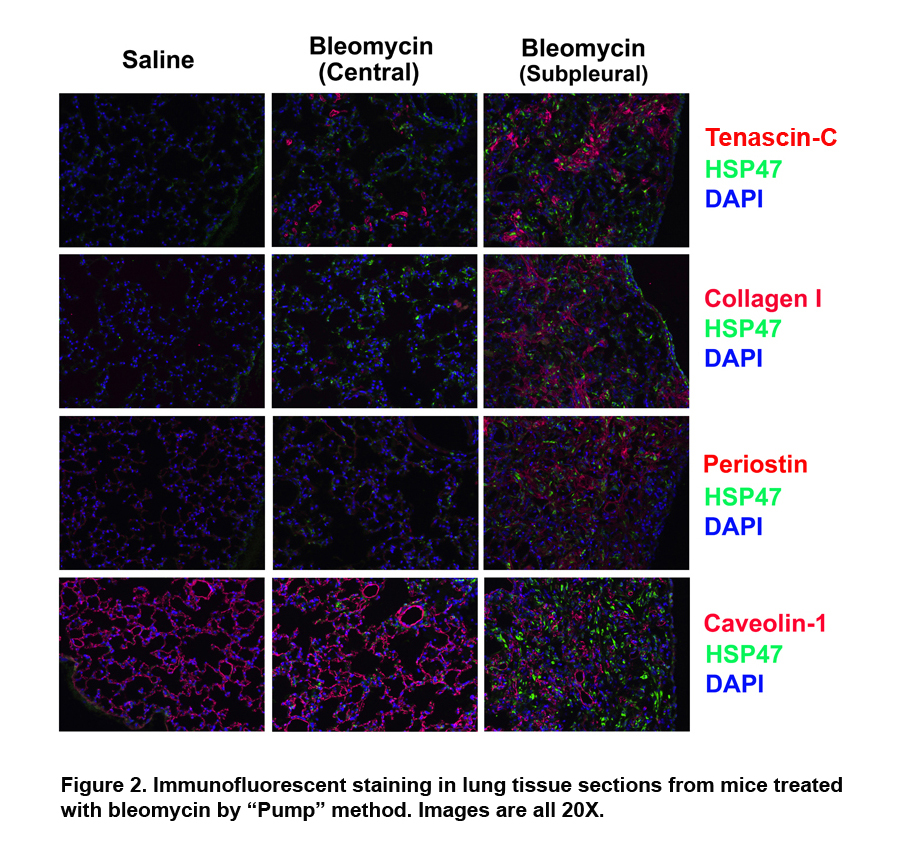Session Information
Title: Systemic Sclerosis, Fibrosing Syndromes and Raynaud’s – Pathogenesis, Animal Models and Genetics
Session Type: Abstract Submissions (ACR)
Background/Purpose:
Interstitial lung disease (ILD) represents a group of chronic, progressive, irreversible diseases associated with pulmonary fibrosis, including systemic sclerosis and idiopathic pulmonary fibrosis. In ILD, pulmonary fibrosis is accompanied by alveolar epithelia cell injury, inflammatory cell accumulation, fibroblast and myofibroblast proliferation, loss of the master regulatory protein caveolin-1 from fibroblasts and inflammatory cells, and excessive deposition of extracellular matrix (ECM) resulting in impairment of pulmonary function. Fibrosis in ILD is predominantly localized in the subpleural region of the lung. ILD is modeled in rodents by bleomycin treatment. In most studies, bleomycin has been delivered directly into the lungs by intratracheal or intraoral administration; however, bleomycin has also been delivered using subcutaneous osmotic pumps. Here we have compared the effects in mice of bleomycin delivered by “Pump” or by the “Direct” route to determine which is a better model for human ILD.
Methods:
Male CD1 mice (ten weeks old) are treated with bleomycin either by the “Direct” route (a single intraoral administration of 2 U/kg) and sacrificed on day 14, or by “Pump” (the pump delivers 100 U/kg continuously over 7 days, then is removed) and sacrificed on day 35. Tissue sections are stained histochemically and immunohistochemically for caveolin-1, inflammatory cell markers, several ECM proteins, and proteins associated with fibrosis. Other methods are used to analyze the progression of inflammation and fibrosis including Western blotting, gelatin zymography, collection of BAL fluid, and flow cytometry. The role of the loss of caveolin-1 in the progression of inflammation and fibrosis is determined by using the caveolin-1 scaffolding domain peptide to restore caveolin-1 function.
Results:
The Pump model provides a much higher level of subpleural fibrosis than the Direct model as evaluated by Masson’s Trichrome stain and immunohistochemistry for the ECM proteins collagen I, tenascin-C, and periostin, and the collagen chaperone HSP47 (Figs. 1 and 2). Conversely, there is a much higher level of inflammatory cell accumulation, weight loss, and death in the Direct model. There is a striking absence of caveolin-1 from the HSP47-positive cells in the Pump model. Experiments are underway to determine the effects of replacing caveolin-1 function in the Pump model.
Conclusion:
The Pump model is superior to the Direct model because: 1) The resulting disease more accurately recapitulates human ILD, and 2) It is more convenient because there is less animal weight loss and death
Disclosure:
R. Lee,
None;
M. Bonner,
None;
C. Reese,
None;
E. Tourkina,
None;
Z. Hajdu,
None;
J. Zhang,
None;
R. Visconti,
None;
S. Hoffman,
None.
« Back to 2012 ACR/ARHP Annual Meeting
ACR Meeting Abstracts - https://acrabstracts.org/abstract/bleomycin-delivery-by-osmotic-pump-a-superior-model-for-human-ild/


